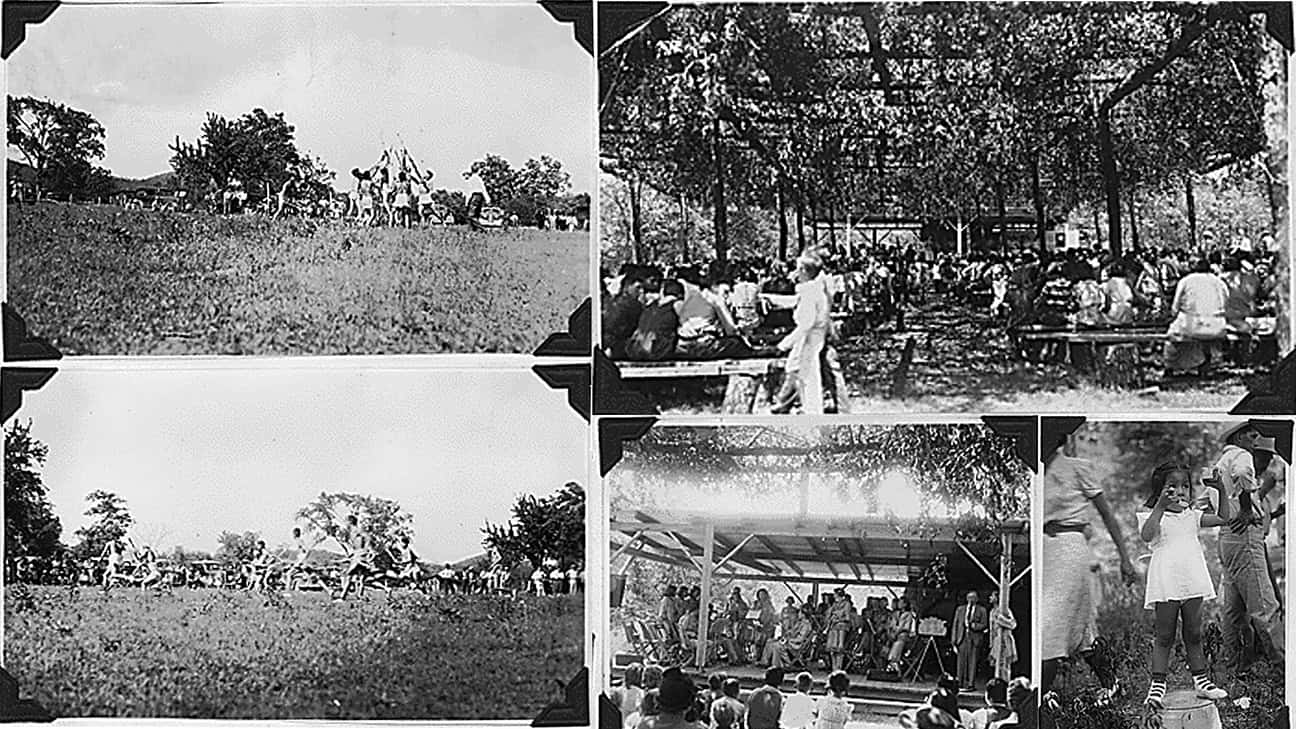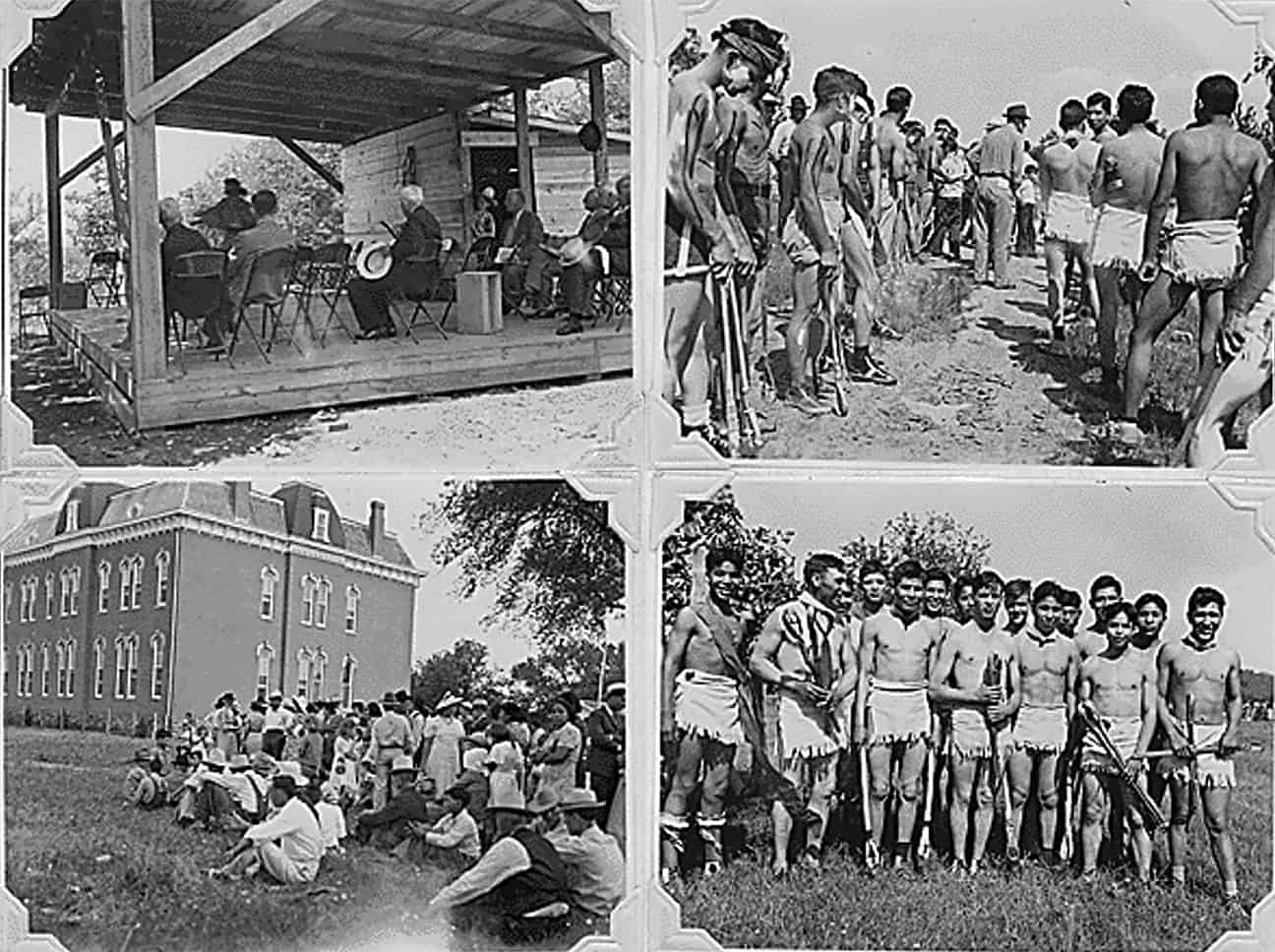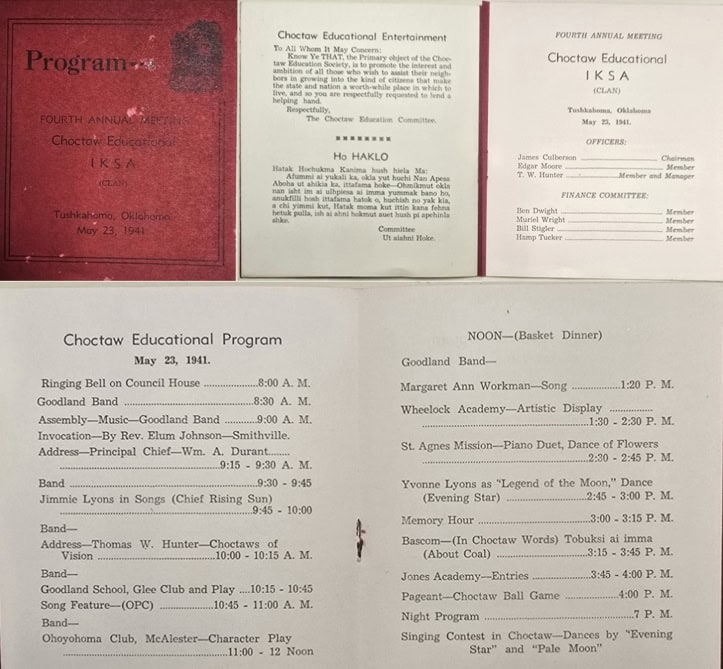
Stickball Games and Live Music at the Choctaw Capitol in 1939.
Labor Day Festival and Annual Iksa Meeting, Part III
Iti FabvssaPublished June 1, 2025By Reno Crims
This month’s edition of Iti Fabvssa is the third in a three-part series that explored the 1938 rebuild of the Choctaw Capitol building and the roots of today’s Labor Day Festival. This month we will be discussing the 1941 and 1942 meetings and how the annual gathering eventually turned into the Labor Day Festival we all know and love today.
The fourth Annual Iksa Meeting took place at the Capitol on Friday, May 23, 1941, and had the typical food and music. There was also an Ishtaboli game between Goodland and Jones Academy. Goodland won 9-0 and the game was described in detail in the local paper. Thomas Hunter presented a speech titled “Choctaws of Vision.” Although the United States would not enter the war until December of that year, Chief Durant felt that Choctaws should rally to support the recently created national defense program and be “prepared to take the warpath again as American soldiers.” Oklahoma Supreme Court Justice Earl Welch, a Chickasaw citizen and local, was also a speaker. The three speeches were translated into Choctaw by James Edwards, who was noted at the time to be a “World War Veteran.” Today, we know him as Choctaw Code Talker James Edwards.
The event had been a large success for four straight years, and the administration rightfully believed they could do more. Later that same year, the Durant Administration created the “Choctaw Indian Fair,” which took place on October 6 and 7 of 1941. Durant and the Advisory Council were able to negotiate with the US Department of Agriculture’s Indian Service to sponsor the event. This iteration of the event introduced more of the carnival elements that we take part in today. Specifically advertised were the showing of quilts, basketry, beadwork, school displays, a canned goods exhibit from local canning clubs and even a nail driving contest for women. A football game was described between Jones and Goodland Academy.
Further developments to the Council Grounds and increasing interest in the event led to regular church services, community singing events and several other offshoots that began with the annual celebration. In documents about the expansion of the grounds and repurposing of the building from 1939 to 1941, the Capitol building was described explicitly as a community center. The administration wanted to use the site as much as possible, with fairs, festivals, political meetings, community outreach and cultural preservation efforts all being centered around the Capitol.

In 1942, the Annual Iksa Meeting that was typically held during May was then moved to October to combine with the 2nd Annual Choctaw Indian Fair. The date was noted to be more significant as the first week of October aligned with the first week of the Choctaw Nation’s government business historically. We see these events conglomerate into something that more closely resembles our current Labor Day Festival.
The general meeting and fair took place on October 5, 1942. On October the 8, a motion was unanimously passed by the Advisory Council and Chief Durant to appropriate the sum of one million dollars of funds on hold at Washington as an endowment for the Goodland Indian Orphanage. With the American war effort in full swing, the presence of great and large pageantry was toned down. The 1942 meeting appears to be the last advertised meeting until after the war. Newspaper records do not detail an annual meeting again until 1948, when newly elected Chief Harry J. W. Belvin “resumed the tradition” and hosted the Choctaw-Chickasaw Labor Day Meet.
The Iksa Organization suffered great loss during the next few years as most of the original Iksa Organization members passed away. In 1943, James Culberson passed, followed by Thomas Hunter in 1944 and Edgar Moore in 1945. Chief William Durant would follow shortly after in the beginning of 1948 followed by Bill Stigler in 1952 and Ben Dwight in 1953.
From 1938 to present time, we have seen nearly continuous annual gatherings on the Capitol grounds. After the passing of Chief William Durant in 1948, Chief Harry Belvin was elected and created what he called the “Choctaw-Chickasaw Labor Day Meet” citing it as a continuance of earlier Choctaw gatherings at the capitol grounds. These meetings also featured speeches from executive officials, addressing tribal affairs, Choctaw singing, and advocating for tribal members to utilize growing educational and vocational opportunities.
The Labor Day Festival is an annual event of cultural preservation and community gathering that was made with considerable oversight and thought. It has taken place in the same location and observed the same core components for nearly a century. At times, there were brief pauses, such as those during World War II and the COVID-19 pandemic, but the event has routinely been picked back up even after changes in administration.
It is also extremely important that we recognize the efforts of the pre-1948 leadership. The rebuilding of the Capitol and the creation of the Annual Iksa Meeting were done with great care and were intentional about preservation and honoring of the past.

The Choctaw Advisory Council and Iksa Organization were all citizens of the Choctaw Nation. Most of them were children and grandchildren of removal survivors. A portion of the group’s legacy was saving the historic Capitol and converting it into a cultural preservation site. They accompanied this effort with an annual event that heavily featured observances of Choctaw language, sports, politics, crafts, and dances.
The Choctaw Capitol Building and the Choctaw Nation Labor Day Festival exist as final gifts from members of the old government to their descendants. Durant and Belvin’s administrations focused on what would later be described as “Choctaw Termination,” and the festival operated as a cultural meeting spot for citizens and leaders to gather and discuss how to best “close business.” They created a place and time for discussions to take place about self-governance and the future of the tribe – even when they thought that it would be short-lived.
It is most fortunate that as Choctaw Termination was overturned. The Labor Day Festival remained a set meeting place for tribal members to discuss and, in many cases, organize and lead themselves. The generations used the event effectively to disseminate ideas, petitions and communicate with broader tribal audiences. On occasion, it was even a place of political protest, such as the petition campaign used by Kenneth Ferguson and the Choctaw Historical Iksa, which would result in the complete restoration and formation of the present Tvshkahomma Capitol Museum.
Since 1976, most Choctaw Nation Chiefs have been sworn in at the annual gathering and until recently, the State of the Nation Address was also given on the grounds during the festivities. When Chief Durant and Chief Belvin delivered the State of the Nation at the Capitol, it echoed the traditions of the Choctaw Nation. Today, due to advances in technology, the Choctaw Nation is now able to remotely broadcast the State of the Nation to tribal members everywhere.
Works Cited
- Mar 27, 1941, page 4 – The Antlers American at Newspapers.com (announcement of 1941 meeting)
- May 28, 1941, page 2 – McCurtain Gazette at Newspapers.com (Thomas Hunter speech and 1941 meeting information)
- May 29, 1941, page 1 – The Antlers American at Newspapers.com (Ishtaboli game 1941 and general information 1941 meeting)
- May 28, 1941, page 2 – McCurtain Gazette at Newspapers.com (1941 speeches and mention of James Edwards)
- Jan 1, 1942, page 4 – The Southeast Oklahoman at Newspapers.com (announcement for 1942 meeting)
- Oct 10, 1942, page 14 – The Daily Oklahoman at Newspapers.com (sale of coal lands during the meeting/fair 1942)
- Oct 13, 1942, page 1 – The Hugo Daily News at Newspapers.com (endowment of funds to Goodland Orphanage)
- Mar 12, 1943, page 4 – Durant Weekly News and Bryan County Democrat at Newspapers.com (Culberson’s Passing)
- Jun 15, 1944, page 2 – The Okfuskee County News at Newspapers.com (Hunter’s Passing)
- Jan 11, 1945, page 1 – The Poteau News at Newspapers.com (Moore’s Passing)
By revisiting the beginnings of the Choctaw Labor Day Festival and educating those around us on the depths of its history, we broaden our understanding of Oklahoma Choctaw. Understanding the history of the Labor Day Festival is not just about the past, it also strengthens our understanding of important concepts like tribal sovereignty in its many forms. Just as Choctaw people do today, past leaders have used the Capitol Grounds and Annual Gathering as a place to reclaim and redevelop their Nation.